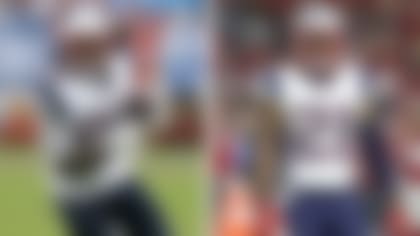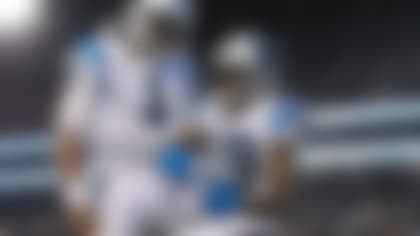It's easy to pencil the New England Patriots into Super Bowl XLIX based on their recent history of destroying the Indianapolis Colts' defense. The Pats have rolled through Chuck Pagano's troops in their two most recent matchups; it is hard to imagine the defense finding an effective solution to slow down an offensive juggernaut that's pummeled Indy with a mix of power runs and explosive passes on the perimeter.
However, after examining the All-22 Coaches Film, I believe the Colts' defense won't just play well in Sunday night's AFC Championship Game -- I think the unit can lead Indy to a stirring road upset by making a few tweaks to the defensive game plan. Now, it will take nearly flawless execution to get it done, but here is how the Colts' defense can help Andrew Luck and Co. walk out of Gillette Stadium with an improbable win:
1) The Colts must play with better gap discipline vs. the Pats' run game.
Whenever a team rushes for 230-plus yards on an opponent in back-to-back meetings -- as the Pats did against Indy in Week 11 of this season and in the postseason a year ago -- it is easy to assume the defense lacks the size and physicality to slow down the running game. However, I believe the Colts' issues defending the Patriots' ground game spawn from the defense failing to properly attack the gaps at the line of scrimmage. Now, I know that simplistic analysis will draw quizzical looks from observers perusing the stat sheets of the past two meetings, but a look at the All-22 Coaches Film suggests the Colts didn't consistently execute their assignments at the point of attack.
Studying the game tape, I was shocked at how often the Colts failed to account for each of the eight gaps along the line. In addition, I noticed the linebackers didn't properly "smash" (force the ball back inside to pursuit) or "spill" (force the ball to bounce outside to an awaiting defender) based on the blocking scheme. Factor in some shoddy tackling, and it's easy to see why Jonas Gray (37 carries for 201 yards and four scores in Week 11) and LeGarrette Blount (24 carries for 166 yards and four scores in the 2013 Divisional Round) have enjoyed banner days against the Colts in the teams' last two meetings.
To their credit, the Patriots have done an exceptional job of mixing in some clever tactics to help their runners find creases in the Colts' defense. New England offensive coordinator Josh McDaniels extensively deployed an unbalanced line in the 42-20 win at Indy back in November, with Cameron Fleming lining up as a sixth offensive lineman. With some extra beef at the line of scrimmage, McDaniels utilized a power-based running game from a number of run-heavy sets that complicated the numbers count at the point of attack.
In the play below, the Patriots are aligned in an Ace Solo formation with Fleming lined up to the right -- at "tight end" -- in an unbalanced line. Gray receives a handoff on an inside zone to the right. The Colts are executing a slant to Fleming's side on the defensive line, with linebackers Jerrell Freeman and D'Qwell Jackson expected to fill the B- and C-gaps on the front side of the defense. Jackson is in decent position on the offensive tackle, but Freeman is cut down by the center, leaving a huge hole in the middle. Gray races through the gap for a 14-yard gain due to poor execution on the second level (TO VIEW THE PLAY, SCROLL LEFT TO RIGHT ON THE IMAGE BELOW):
In the following play, New England is aligned in a tight Ace Wing formation, with Fleming positioned at tight end on the right side. The Colts' linebackers are expected to read their keys and flow in the direction of the runner. The Patriots hand the ball to Gray on an inside-zone run play to the right. Jackson flows freely to the ball and attacks Gray in the hole. Unfortunately, Jackson fails to bring the runner down and Gray picks up positive yards on a play that should've been stuffed (TO VIEW THE PLAY, SCROLL LEFT TO RIGHT ON THE IMAGE BELOW):
In the next play, the Patriots are aligned in an unbalanced Ace formation with wide receiver Julian Edelman lined up in a "nasty" position near Fleming. The Colts' linebackers are expected to read their keys and make a play on the runner based on the blocking at the point of attack. And this time, they succeed. Freeman identifies the pulling guard (Dan Connolly) and attacks to the inside, forcing Gray to bounce to an awaiting Jackson, who is flying over the top. When the defense executed this simple maneuver at the point of attack, the Colts were able to slow down the Patriots' running game (TO VIEW THE PLAY, SCROLL LEFT TO RIGHT ON THE IMAGE BELOW):
Below, the Patriots are aligned in a tight Ace Wing formation with Fleming positioned at tight end beside Gronkowski. Gray receives the handoff on a counter to the strong side. The Colts play it perfectly at the point of attack with Montori Hughes penetrating the A-gap. Defensive lineman Cory Redding occupies a double team on the strong side, freeing Jackson to run over the top. Safety Mike Adams sets the edge as the force defender, preventing Gray from turning the corner and leading to a minimal gain on the play (TO VIEW THE PLAY, SCROLL LEFT TO RIGHT ON THE IMAGE BELOW):
The Colts had some success with run blitzes when they executed them correctly at the line of scrimmage. In the next play, the Patriots are in an unbalanced I-formation with Fleming positioned at tight end to the right. Outside linebacker Bjoern Werner crashes through the C-gap on a blitz, with safety Sergio Brown also attacking off the edge. When Fleming steps out to block Brown, Werner shoots the gap and delivers a big hit on Gray in the backfield (TO VIEW THE PLAY, SCROLL LEFT TO RIGHT ON THE IMAGE BELOW):
In the end, the Colts' ability to slow down the Patriots' running game will come down to executing a few simple tactics that were likely a part of their minicamp installation. If the defense accounts for each gap along the line and the linebackers use proper technique to force the ball back to the pursuit, Indy can contain the run and force Tom Brady to win the game through the air.
2) Greg Manusky must attack Tom Brady with blitzes/simulated pressures.
Harrison: Power Rankings
What does the NFL landscape look like heading into Championship Sunday? Elliot Harrison reveals his pecking order. **READ**
Yes, Brady certainly has the ability to make foes pay for blitzing, but opposing defensive coordinators cannot allow fear to water down their game plan. Employing a clever cat-and-mouse game at the line of scrimmage remains the best way to disrupt the future Hall of Famer's timing and rhythm in the pocket. Thus, Manusky should bring a variety of overload blitzes (four rushers from one side) and attack through the A-gaps to quicken the clock in Brady's head, hopefully forcing him to make some bad decisions.
Additionally, the Colts need to mix in some simulated pressures to bait the veteran into checking to blitz-beaters against zones with seven or eight defenders in coverage. These looks are very effective from a 3-4 scheme because quarterbacks have a tough time determining which defenders are poised to rush, with multiple linebackers and defensive backs in standup positions near the line of scrimmage.
In the example below, the Colts are showing a double A-gap blitz with Freeman and Jackson on each side of the center. Brady anticipates the blitz and checks into a play designed to beat the rush. Gronkowski motions across the formation before racing to the flat as the first option in the route. The Colts drop out into soft zone with a four-man rush. Brady is surprised by the tactic and unable to find an open receiver against the coverage. Eventually, he's forced to throw the ball out of bounds to avoid making a mistake against a coverage that fooled him during the pre-snap phase (TO VIEW THE PLAY, SCROLL LEFT TO RIGHT ON THE IMAGE BELOW):
Brady remains one of the top quarterbacks in the game, but he is not above making mistakes when opponents are able to get rushers in his face consistently. The Colts have the athletes along the line of scrimmage and in the back end to blitz and bluff, which is the way to throw Brady off his game.
3) Indianapolis must focus on stopping Rob Gronkowski in the red zone.
There is no doubt in league circles that Gronkowski is the most dangerous red-zone weapon in football today. He has the most receiving touchdowns by a tight end in the first five seasons of a career (54) and enters the AFC Championship Game with nine TDs over his last nine outings.
Given those numbers and the fact that he is unquestionably the Patriots' top target in the passing game, the Colts must account for Gronkowski's whereabouts in every situation, particularly down near the end zone. While that has been the thought of every defensive coordinator that has faced the Patriots for quite some time, few have been able to execute the plan in big games. Coaches have tried a variety of tactics to slow down Gronkowski -- from jamming the big-bodied tight end with a linebacker and deploying a safety over the top to using a bracket with nickel corners and safeties -- but few have been able to keep the Pro Bowler from putting the ball in the paint.
However, the Colts would be wise to use a strategy employed by former Patriots defensive coordinator Romeo Crennel against top tight ends -- put a "vise" bracket on the pass catcher in the red zone. The technique is similar to the double-teams routinely executed by punt return teams on opposing gunners. Check out the following two screengrabs from back in 2011, when Crennel's Chiefs employed the tactic against Chargers tight end Antonio Gates:
[![internal-link-placeholder-0]](http://static.nfl.com/static/content/public/photo/2015/01/15/0ap3000000459314.jpg)
[![internal-link-placeholder-0]](http://static.nfl.com/static/content/public/photo/2015/01/15/0ap3000000459315.jpg)
This approach makes it nearly impossible for a player to get open early in the play. Most importantly, it discourages the opposing quarterback from even looking in his favorite target's direction, forcing him to find another weapon in this critical area of the field.
Follow Bucky Brooks on Twitter @BuckyBrooks.












